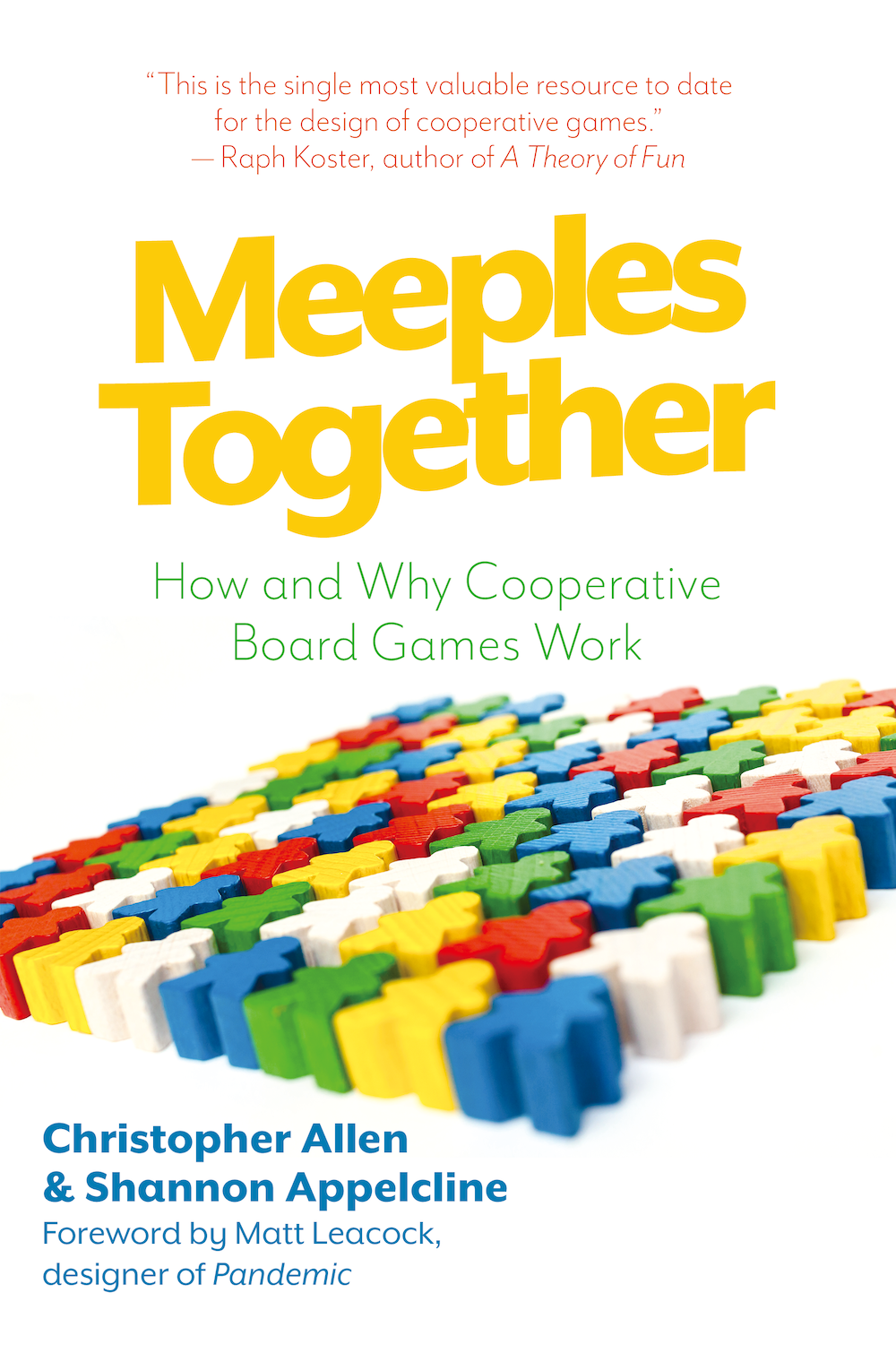Meeples Together
How and Why Cooperative Games Work
The authoritative source on cooperative board games and card games for gamers, aficionados, critics, and designers, featuring a deep dive into co-op gaming’s titles, mechanics, theory, and frontiers. Join the party.
“Meeples Together is a must-buy book for anybody who is even remotely interested in cooperative gaming.… It is one of these rare books that takes our hobby to the next level, probably because it is written by gamers, for gamers.” — Antonios S, review at RPG.net
Meeples Together
by Christopher Allen and Shannon Appelcline
Foreword by Matt Leacock
Print Edition:
ISBN: 978-0-9818840-8-0
6×9 inches • 380 pages • softcover
$24.95 (US)
About the Book
It wouldn’t be a stretch to say that civilization is built on cooperation. It’s all about different people working together to overcome challenges and build amazing successes — and then celebrating the camaraderie of their shared achievements. The best cooperative games are like that too.
Join experts Christopher Allen and Shannon Appelcline as they examine not only how cooperative board games work, but why. With more than 150 enlightening illustrations and 14 in-depth case studies showing principles and mechanisms of play in action, this book helps you to see your favorite cooperative board games in new ways.
Whether you want to play cooperative games better, discover your next favorite game, or design the world’s next favorite, Meeples Together is for you.
Digital Editions:
Rich-featured digitally native PDF, Epub, and Kindle formats, available now:
- at DriveThru
- at Indie Press Revolution (IPR) and Print + PDF Bundle (IPR)
- at Warehouse 23
- at Amazon
- at Apple
Table of Contents
Foreword by Matt Leacock
Chapter 1: The Basics of Cooperation
Part One: The Spectrum of Cooperative Gaming
Chapter 2: Styles of Competition
Case Study: Terra
Chapter 3: Styles of Teamwork
Case Study: Contract Bridge
Case Study: One Night Ultimate Werewolf
Chapter 4: Styles of Cooperation
Case Study: Pandemic
Case Study: Forbidden Island
Case Study: Forbidden Desert
Part Two: The Mechanics of Cooperative Games
Chapter 5: Cooperative Systems
Case Study: Flash Point: Fire Rescue
Chapter 6: Challenge Systems
Case Study: Robinson Crusoe — Adventures on the Cursed Island
Chapter 7: Players Facing Challenges
Case Study: Shadows over Camelot
Case Study: Battlestar Galactica: The Board Game
Chapter 8: Players Undertaking Tasks
Case Study: Arkham Horror 2e
Chapter 9: Adventure Systems
Case Study: Mansions of Madness 2e
Part Three: The Theory of Cooperative Games
Chapter 10: A Theory of Cooperative Gaming
Case Study: Space Alert
Chapter 11: A Theory of Challenge Design
Case Study: Ghost Stories
Chapter 12: When Games Go Wrong
Case Study: D-Day Dice
Part Four: Cooperative Frontiers
Chapter 13: The Psychology of Cooperative Gaming
Case Study: Hanabi
Chapter 14: Assembling the Puzzle
Case Study: SOS Titanic
Appendices
Appendix I: The Basics of Game Design
Appendix II: Game Design Dilemmas
Appendix III: Game Design Types
Appendix IV: Game Design & Social Theories
Appendix V: Cooperative & Teamwork Game Synopses & Reviews
The Meeples Together Blog
Christopher Allen and Shannon Appelcline maintain a blog and social media accounts for Meeples Together. Check them out!
About the Authors
Christopher Allen writes about collaboration. He’s founded several companies focusing on social software, including Skotos Tech, an online game company where he aided in the design of Castle Marrach, Grendel’s Revenge, and Lovecraft Country. His Life with Alacrity blog talks about the principles of cooperation, collaboration, and governance while his Rebooting the Web of Trust workshops imagine the future of collaboration on the internet.
Shannon Appelcline writes about games. He regularly contributed to the defunct board-gaming magazine Knucklebones, while his eurogame-focused Meeples & Mechanics blog contains over a decade worth of game analysis. He’s also long been involved with the roleplaying field, working for Chaosium and supporting lines like Call of Cthulhu and Pendragon. He’s best known for Designers & Dragons, a four-book history of the roleplaying industry.

